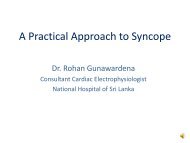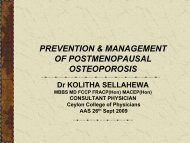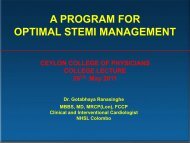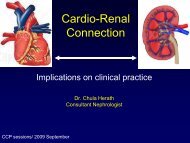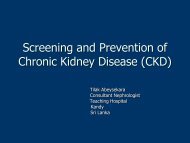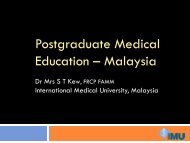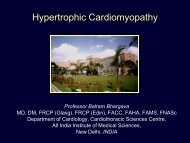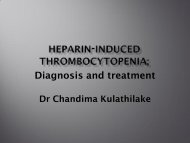systematic reviews, meta-analysis & evidence based medicine
systematic reviews, meta-analysis & evidence based medicine
systematic reviews, meta-analysis & evidence based medicine
You also want an ePaper? Increase the reach of your titles
YUMPU automatically turns print PDFs into web optimized ePapers that Google loves.
The Need for Evidence Based<br />
Medicine<br />
Prof. Prathap Tharyan MD, MRCPsych<br />
Professor of Psychiatry & Associate Director<br />
Christian Medical College, Vellore<br />
Director, South Asian Cochrane Network & Centre<br />
Editor, Cochrane Schizophrenia Group<br />
Prof. BV Moses & ICMR Centre for Advanced Research &<br />
Training in Evidence-Informed Healthcare<br />
Christian Medical College, Vellore, Tamil Nadu, India
EVIDENCE BASED MEDICINE<br />
• The integration of<br />
research <strong>evidence</strong>,<br />
clinical expertise<br />
and patient values<br />
(Sackett et al, 2000)<br />
Evidence-Based Medicine Working Group: Evidence-<strong>based</strong> <strong>medicine</strong>. A<br />
new approach to teaching the practice of <strong>medicine</strong>. JAMA. 1992;268:<br />
2420-5<br />
http://www.cebm.utoronto.ca/
Evidence Based Medicine<br />
• I: Getting the right <strong>evidence</strong><br />
• II: Getting the <strong>evidence</strong> used
Getting the right <strong>evidence</strong><br />
What is needed<br />
• Ensure all relevant research is considered<br />
• Critically appraise research for quality and<br />
applicability<br />
• Synthesize research findings using appropriate<br />
methods
Why is reliable <strong>evidence</strong> important<br />
Hormone replacement therapy for post-menopausal<br />
women provides an instructive example<br />
• For a decade, organizations recommended that clinicians<br />
encourage postmenopausal women to use hormone<br />
replacement therapy believing this would reduce<br />
cardiovascular risks<br />
• Because the data came from observational studies with<br />
inconsistent results, the <strong>evidence</strong> for a reduction in<br />
cardiovascular risk was of very low quality (unreliable)
Evidence from RCTs
Farquhar C, MarjoribanksJ, LethabyA, Suckling JA, Lamberts Q. Long term hormone<br />
therapy for peri-menopausal and postmenopausal women. Cochrane Database<br />
of Systematic Reviews 2009, Issue 2. Art. No.: CD004143<br />
• Objectives<br />
To assess the effect of long-term HT on mortality,<br />
cardiovascular outcomes, cancer, gallbladder<br />
disease, cognition, fractures and quality of life.<br />
• Selection criteria<br />
Randomised double-blind trials of HT versus<br />
placebo, taken for at least one year by perimenopausal<br />
or postmenopausal women.<br />
HT included oestrogens, with or without<br />
progestogens, via oral, trans-dermal,<br />
subcutaneous or trans-nasal routes.
Farquhar C, MarjoribanksJ, LethabyA, Suckling JA, Lamberts Q.<br />
Long term hormone therapy for peri-menopausal and<br />
postmenopausal women. Cochrane Database of Systematic Reviews<br />
2009, Issue 2. Art. No.: CD004143<br />
• Main results<br />
• Nineteen trials involving 41,904 women were included.<br />
• In relatively healthy women, combined continuous HT<br />
significantly increased the risk of venous thromboembolism<br />
or coronary event (after one year’s use),<br />
stroke (after three years), breast cancer and<br />
gallbladder disease.<br />
• Long-term oestrogen-only HT significantly increased<br />
the risk of venous thrombo-embolism, stroke and<br />
gallbladder disease (after one to two years, three years<br />
and seven years’ use respectively), but did not<br />
significantly increase the risk of breast cancer.
Farquhar C, MarjoribanksJ, LethabyA, Suckling JA, Lamberts Q.<br />
Long term hormone therapy for peri-menopausal and<br />
postmenopausal women. Cochrane Database of Systematic Reviews<br />
2009, Issue 2. Art. No.: CD004143<br />
• Main results (cont..)<br />
• The only statistically significant benefits of HT were a<br />
decreased incidence of fractures and (for combined HT)<br />
colon cancer, with long-term use.<br />
• Among women aged over 65 who were relatively healthy<br />
(i.e. generally fit, without overt disease) and taking<br />
continuous combined HT, there was a statistically<br />
significant increase in the incidence of dementia.<br />
• Among women with cardiovascular disease, long-term<br />
use of combined continuous HT significantly increased<br />
the risk of venous thrombo-embolism.
Farquhar C, MarjoribanksJ, LethabyA, Suckling JA, Lamberts Q.<br />
Long term hormone therapy for peri-menopausal and<br />
postmenopausal women. Cochrane Database of Systematic Reviews<br />
2009, Issue 2. Art. No.: CD004143<br />
• Authors’ conclusions<br />
HT is not indicated for the routine management of<br />
chronic disease.<br />
We need more <strong>evidence</strong> on the safety of HT for<br />
menopausal symptom control, though short-term use<br />
appears to be relatively safe for healthy younger<br />
women
The Need for Evidence:<br />
1. Reliable <strong>evidence</strong> is needed to optimize healthcare<br />
outcomes and prevent harms
Is bed rest necessary after spinal puncture<br />
Why<br />
• Is bed rest after spinal puncture helpful<br />
A <strong>systematic</strong> review of trials<br />
Allen, Glasziou, Del Mar. Lancet, 1999<br />
• 10 trials of bed rest after spinal puncture<br />
no change in headache with bed rest<br />
Increase in back pain<br />
• Protocols in UK neurology units - 80% still recommend bed<br />
rest after LP<br />
Serpell M, BMJ 1998;316:1709–10<br />
• …<strong>evidence</strong> of harm available for 17 years preceding...
The Need for Evidence:<br />
2. A lot of the <strong>medicine</strong> we practice is not <strong>evidence</strong><br />
<strong>based</strong>
Reduced osmolarity<br />
rehydration solution
Need for unscheduled<br />
intravenous fluid infusion
A large international trial<br />
comparing magnesium<br />
sulphate with placebo for the<br />
treatment of pre-eclampsia;<br />
evaluating the effects on<br />
women and their babies
The Need for Evidence:<br />
3. Reliable <strong>evidence</strong> improves standards of care
Antenatal care<br />
A reduction in the number of<br />
antenatal care visits with or<br />
without an increased<br />
emphasis on the content of<br />
the visits could be<br />
implemented without any<br />
increase in adverse maternal<br />
and perinatal outcomes.
The need for Evidence:<br />
4. Reliable <strong>evidence</strong> optimizes resource utilization
The need for <strong>evidence</strong>:<br />
5. Reliable <strong>evidence</strong> saves lives
Need for EBM-the Bottom Line:<br />
Scarcity of resources<br />
• Wherever health care is provided and used, it is<br />
essential to know which interventions work,<br />
which do not work, and which are likely to be<br />
harmful.<br />
• This is especially important in situations where<br />
health problems are severe and the scarcity of<br />
resources makes it vital that they are not wasted<br />
• EBM has a particular relevance to the<br />
developing world
“If you are poor, actually you need more<br />
<strong>evidence</strong> before you invest, rather than<br />
if you are rich.”
Finding reliable <strong>evidence</strong>
Inadequacy of traditional sources of<br />
information<br />
• Text books rapidly are out of date<br />
<br />
Antman et al. A comparison of results of <strong>meta</strong>-analyses of randomised control trials and<br />
recommendations of clinical experts. JAMA 1992;268:240-8.<br />
• Experts are frequently wrong<br />
Oxman A, Guyatt GH: The science of reviewing research. Ann NY Acad Sci 1993;703:125-<br />
134<br />
• Didactic CME not effective in changing practice<br />
<br />
Davis D A, Thomson M A, Oxman A D, Haynes R B: Changing physician performance: a<br />
<strong>systematic</strong> review of the effect of continuing medical education strategies. JAMA<br />
1997;274:700-5.<br />
• Medical Journals are too many and of variable quality<br />
<br />
Haynes RB. Where's the Meat in Clinical Journals [editorial] ACP Journal Club.<br />
1993;119:A-22-3.<br />
EBM. Sackett et al 2000
How much confidence do we place in<br />
<strong>evidence</strong><br />
• Not all <strong>evidence</strong> is equally convincing.<br />
• How convincing <strong>evidence</strong> is (for effects of<br />
interventions) should be <strong>based</strong> on criteria such as:<br />
What sort of observations<br />
How well they were done (internal validity)<br />
How directly relevant they are (external validity)<br />
How many there are<br />
How effective is the intervention<br />
How consistent they are<br />
• NOT on who says it or how they say it.
Not all <strong>evidence</strong> is equally convincing: Levels of Evidence<br />
Level Intervention Prognosis Diagnosis Etiology<br />
Least biased<br />
I<br />
Systematic Review<br />
of level II studies<br />
Systematic Review<br />
of Level II studies<br />
Systematic Review<br />
of Level II studies<br />
Systematic Review<br />
of Level II studies<br />
II RCT Inception cohort<br />
study<br />
Cross sectional<br />
study among<br />
consecutive<br />
patients<br />
Prospective cohort<br />
study<br />
III<br />
•Non-randomized<br />
controlled clinical<br />
trial<br />
•Controlled before<br />
and after study<br />
•Cohort study<br />
•Case control study<br />
•Untreated<br />
controls in an RCT<br />
•Retrospectively<br />
assembled cohort<br />
study<br />
•Cross sectional<br />
study among nonconsecutive<br />
patients<br />
•Case control study<br />
•Retrospective<br />
cohort study<br />
•Case control study<br />
Most biased<br />
IV<br />
Case series Case series Case series<br />
Cohort of patients<br />
at different stages<br />
of disease<br />
Cross sectional<br />
study
What is a <strong>systematic</strong> review <br />
“A review in which bias has been reduced by the<br />
<strong>systematic</strong> identification, appraisal, synthesis,<br />
and, if relevant, statistical aggregation of all<br />
relevant studies on a specific topic according<br />
to a predetermined and explicit method.”<br />
Moher et al Lancet 1999<br />
• Many (not all) <strong>systematic</strong> <strong>reviews</strong> use <strong>meta</strong><br />
<strong>analysis</strong> to synthesize data
What is <strong>meta</strong> <strong>analysis</strong> <br />
• “the statistical method that combines the<br />
results of several independent studies”
In practice, not all <strong>meta</strong>-analyses are conducted as part<br />
of <strong>systematic</strong> <strong>reviews</strong><br />
Metaanalyses<br />
Individual patient<br />
data (IPD) <strong>meta</strong>analyses<br />
All <strong>reviews</strong><br />
Reviews that<br />
are not<br />
<strong>systematic</strong><br />
(traditional,<br />
narrative<br />
<strong>reviews</strong>)<br />
Systematic<br />
<strong>reviews</strong>
Traditional Approach To Synthesizing The<br />
Evidence<br />
• Review article<br />
• Written by an expert<br />
• Medline search for trials<br />
• Personal contacts<br />
• Number of trials for and against<br />
• Conclusion<br />
• Influential
Traditional (Narrative)Review<br />
Systematic Review<br />
No Methods section; not reproducible<br />
Limited searching for trials (often limited<br />
to Medline); leads to ‘publication bias’<br />
Include different study designs, often do<br />
not evaluate validity<br />
Over-reliance on p values<br />
Uses ‘vote counting’; each trial given<br />
same weight<br />
Descriptive<br />
Subjective; Biased<br />
Clearly described protocol with detailed<br />
methods<br />
Comprehensive searching for published<br />
and unpublished trials with no language<br />
restrictions<br />
Mostly include only RCTs; evaluates<br />
validity<br />
Estimates size of effect with confidence<br />
intervals (precision)<br />
Differentially weights trials so that larger<br />
trials with more information and precise<br />
results are given more weight<br />
Meta-<strong>analysis</strong> pools results of similar<br />
trials; provides a ‘tower of power’<br />
Objective ( two or more authors who<br />
independently undertake review)
Problems with traditional<br />
<strong>reviews</strong><br />
• Lag behind and often vary significantly from<br />
continuously updated or cumulative <strong>meta</strong><strong>analysis</strong><br />
(Lau et al 1992)
33 TRIALS<br />
1959 to 1988<br />
36,974 Pts<br />
I.V.<br />
STREPTOKINASE<br />
FOR ACUTE MI<br />
CUMULATIVE<br />
META-ANALYSIS
Routine<br />
Specific<br />
Rare/Never<br />
Experimental<br />
Not Mentioned<br />
Thrombolysis for Acute MI<br />
Cumulative<br />
Year<br />
RCTs<br />
1960 1<br />
2<br />
1965 3<br />
1970 4<br />
7<br />
10<br />
11<br />
15<br />
17<br />
22<br />
1980 23<br />
27<br />
1985 30<br />
33<br />
43<br />
54<br />
65<br />
1990 67<br />
70<br />
Pts<br />
23<br />
65<br />
149<br />
316<br />
1763<br />
2544<br />
2651<br />
3311<br />
3929<br />
5452<br />
5767<br />
6125<br />
6346<br />
6571<br />
21059<br />
22051<br />
47185<br />
47531<br />
48154<br />
0.5 1.0 2.0<br />
Favors Treatment<br />
Odds Ratio (Log Scale)<br />
P < 0.01<br />
P < 0.001<br />
P < 0.00001<br />
Favors Control<br />
M<br />
M<br />
M<br />
M<br />
M<br />
M<br />
Textbook/Review<br />
Recommendations<br />
21<br />
5<br />
1 10<br />
1 2<br />
2 8<br />
7<br />
8<br />
1 12<br />
1 8 4<br />
1 7 3<br />
5 2 2 1<br />
15 8 1<br />
6 1<br />
Antman et al., JAMA, 1992; 268: 240-248
Prophylactic Lidocaine after acute MI<br />
Antman et al., JAMA, 1992; 268: 240-248
Reduction of perioperative deaths by antibiotic prophylaxis for<br />
colorectal surgery (cumulative <strong>meta</strong>-<strong>analysis</strong>)<br />
Conclusive<br />
<strong>evidence</strong> of<br />
effect<br />
Savulescu, J. et al. BMJ 1996;313:1390-1393<br />
Copyright ©1996 BMJ Publishing Group Ltd.
Putting clinical trials into context<br />
“From August, 2005, we will require authors of clinical trials<br />
submitted to The Lancet to include a clear summary of<br />
previous research findings, and to explain how their<br />
trial’s findings affect this summary.<br />
The relation between existing and new <strong>evidence</strong> should be<br />
illustrated by direct reference to an existing <strong>systematic</strong><br />
review and <strong>meta</strong>-<strong>analysis</strong>.<br />
When a <strong>systematic</strong> review or <strong>meta</strong>-<strong>analysis</strong> does not exist,<br />
authors are encouraged to do their own.<br />
Lancet editorial: 2005; July 9, 366: 107-8.
Criticisms of <strong>systematic</strong> <strong>reviews</strong><br />
“Exercise in mega silliness” (Eysenck 1978)<br />
“Adding apples and oranges can render<br />
the exercise fruitless” (Eysenck 1995)
When can <strong>meta</strong>-analyses<br />
mislead<br />
• When a <strong>meta</strong>-<strong>analysis</strong> is done outside of a <strong>systematic</strong> review<br />
• When poor quality studies are included or when quality issues are<br />
ignored<br />
• When inadequate attention is given to heterogeneity<br />
<br />
Indiscriminate data aggregation can lead to inaccurate conclusions<br />
• When reporting biases are a problem<br />
<br />
<br />
<br />
<br />
<br />
<br />
Publication bias<br />
Time lag bias<br />
Duplicate publication bias<br />
Language bias<br />
Outcome reporting bias<br />
Citation bias<br />
Egger M et al. Uses and abuses of <strong>meta</strong>-<strong>analysis</strong>. Clinical<br />
Medicine 2001;1:478-84
Can <strong>meta</strong>-<strong>analysis</strong> be trusted <br />
• Outcome of 12 large RCTs not predicted<br />
accurately 35% of time by <strong>meta</strong>-analyses<br />
published previously<br />
(Lelorier et al 1997)
META ANALYSES TEND TO<br />
OVER ESTIMATE EFFECTS
www.cochrane.org
Archie Cochrane<br />
“It is surely a great criticism of our profession that we<br />
have not organised a critical summary, by specialty or<br />
subspecialty, adapted periodically, of all relevant<br />
randomised controlled trials.”
What does the Cochrane<br />
Collaboration have to offer<br />
• Largest organization in the world devoted to<br />
producing, disseminating and maintaining<br />
<strong>systematic</strong> <strong>reviews</strong> (SRs) of the effects of<br />
interventions<br />
• Also involved in producing SRs of the accuracy<br />
of diagnostic tests<br />
• >20,000 volunteers who share common<br />
principles (www.cochrane.org)<br />
• Main output is The Cochrane Library
Cochrane Centres<br />
Born on the 15 th of July 2008<br />
Canadian<br />
US<br />
UK<br />
Nordic<br />
German<br />
Dutch<br />
Italian<br />
Iberoamerican<br />
SASIANCC<br />
Chinese<br />
Brazilian<br />
South African<br />
Australasian
Conceived 4 years earlier; Goa: December 2004
The South Asian Cochrane Network<br />
South Asian Association of Regional Cooperation<br />
(SAARC)
Network Sites in India<br />
Chandigargh<br />
Delhi<br />
•All India Institute of<br />
Medical Sciences<br />
(New Delhi)<br />
•Post Graduate<br />
Institute, Chandigarh<br />
•Tata Memorial<br />
Hospital, Mumbai<br />
•Manipal University,<br />
Manipal<br />
Mumbai<br />
•Ramaratnam<br />
Epilepsy Foundation,<br />
Chennai<br />
•CMC, Vellore<br />
Manipal<br />
Chennai<br />
Vellore
Network Sites in Pakistan<br />
Aga Khan<br />
University;<br />
Karachi<br />
Khyber<br />
Medical<br />
University;<br />
Peshawar
Network Site in Sri Lanka<br />
University of<br />
Kelaniya;<br />
Ragama<br />
Ragama
Network Site in Bangladesh<br />
Independent<br />
University,<br />
Dhaka<br />
IDDRB:,<br />
Dhaka
July 15, 2008
Prof BV Moses & Indian Council of Medical<br />
Research Centre for Advanced Research &<br />
Training in Evidence Informed Healthcare<br />
Christian Medical College, Vellore
Relevance of the SASIANCC to<br />
health care in South Asia<br />
• Ask questions about efficacy of interventions of relevance to<br />
health care in the region<br />
• Train people to do <strong>systematic</strong> <strong>reviews</strong><br />
• Disseminate <strong>evidence</strong> from Systematic Reviews<br />
Access to the Cochrane Library<br />
Evidence Based Summaries<br />
• Identify all RCTs and controlled clinical trials from the region<br />
South Asian Database of Controlled Clinical Trials<br />
National Register of Dissertations<br />
Prospective registration of trials<br />
Improve the quality of research conducted<br />
• Orient and train health professions and policy makers in EBM<br />
• Use results of Systematic Reviews to guide health care &<br />
policy
Introduction to Evidence<br />
Based Health Care
Training review authors: protocol<br />
development workshops
Review Completion workshops
SACN participation in <strong>systematic</strong><br />
<strong>reviews</strong> (Cochrane Library Issue 2, 2005<br />
& 2009)<br />
Country Reviews Protocols Titles Total<br />
2005 2009 2005 2009 2005 2009 2005 2009<br />
India 11 36 19 36 33 43 63 109<br />
Pakistan 1 9 3 13 9 12 13 34<br />
Sri Lanka 2 2 1 1 3 3 6<br />
Bangladesh 2 1 1 2 2<br />
Combined 15 48 23 50 42 59 81 151
Growth of contributors in<br />
India<br />
B C AC<br />
2000 2002 2003 2004 2005 2006 2007 2009<br />
Authors 11 15 20 31 42 80 78 248<br />
Editors 2 1 2 5 5 5 5 8<br />
Others 2 15 18 28 19 35 43 284<br />
Total 19 31 40 64 76 120 126 540
www.thecochranelibrary.com
About the Cochrane Collaboration 94<br />
WHAT IS THE COCHRANE LIBRARY`<br />
The Cochrane Library is a collection of Evidence-Based<br />
Medicine databases:<br />
Database Issue 3 2009<br />
The Cochrane Database of Systematic Reviews (CDSR; Cochrane Reviews) 5821<br />
The Cochrane Database of Reviews of Effects (DARE; Other Reviews) 10,894<br />
The Cochrane Central Register of Controlled Trials (CENTRAL; Clinical<br />
Trials)<br />
5,86,829<br />
The Cochrane Methodology Register (CMR; Methods Studies) 11,837<br />
Health Technology Assessment Database (HTA; Technology Assessments) 7947<br />
NHS Economic Evaluation Database (NHSEED; Economic Evaluations) 26,917
Are Cochrane Systematic Reviews<br />
different from other <strong>systematic</strong><br />
<strong>reviews</strong><br />
• Only about 20% of <strong>reviews</strong> published each year are Cochrane<br />
Systematic Reviews<br />
• Cochrane Systematic Reviews emphasize methodological rigour<br />
Found to be of better quality, more up to date, & less biased in<br />
methods and interpretation than non-Cochrane <strong>systematic</strong><br />
<strong>reviews</strong><br />
Free of conflicted sources of funding<br />
• Used to inform practice guidelines of the WHO, many policy making<br />
bodies world-wide; have changed health practices too<br />
Jadad et al. Methodology and reports of <strong>systematic</strong> <strong>reviews</strong> and <strong>meta</strong>-analyses: a<br />
comparison of Cochrane <strong>reviews</strong> with articles published in paper-<strong>based</strong> journals. JAMA<br />
1998;280:278-280.<br />
Moher D, et al. Epidemiology and reporting characteristics of <strong>systematic</strong> <strong>reviews</strong>. PLoS<br />
Med 2007; 4(3): e78. doi:10.1371/journal. pmed.0040078
Access to reliable <strong>evidence</strong> is crucial<br />
The Cochrane Library<br />
Evidence Based Journals and Text Books<br />
Evidence Based Summaries
Free access to the Cochrane<br />
Library to anyone in India<br />
The Telegraph, Kolkatta; Feb 3, 2007
Free access to the Cochrane<br />
Library to anyone in India
Do Indians use the Cochrane Library
Country Visits 2006 Visits 2007 Visits 2008 % Growth 2007-<br />
2008<br />
United States 608,712 1,012,389 1,545,125 52.62%<br />
United Kingdom 595,807 948,750 856,522 -9.72%<br />
Australia 309,487 373,486 457,584 22.52%<br />
Canada 280,124 181,775 203,699 12.06%<br />
Netherlands 183,298 121,935 143,901 18.01%<br />
Taiwan 133,259 89,185 120,529 35.14%<br />
Sweden 68,243 85,416 87,192 2.08%<br />
Italy 61,483 83,198 97,865 17.63%<br />
Germany 53,209 82,071 98,537 20.06%<br />
Norway 53,142 68,694 74,335 8.21%<br />
Japan 52,936 62,649 69,228 10.50%<br />
India 48,940 53,041 63,679 20.06%<br />
Ireland 42,625 50,726 59,642 17.58%<br />
Visits to the Cochrane Library 2006-2008<br />
India shows same growth rate as Germany on visits.
10000<br />
Usage in India: Abstracts<br />
2006-2008<br />
9000<br />
8000<br />
7000<br />
6000<br />
5000<br />
4000<br />
Abstracts 2008<br />
Abstracts 2007<br />
Abstracts 2006<br />
3000<br />
2000<br />
1000<br />
0<br />
January February March April May June July August<br />
September<br />
October<br />
November December
Full Text 2008<br />
Full Text 2007<br />
Full Text 2006<br />
Searches 2008<br />
Searches 2007<br />
Searches 2006<br />
Abstracts<br />
2008<br />
Abstracts 2007<br />
Abstracts<br />
2006<br />
0 10000 20000 30000 40000 50000 60000 70000
Overall growth on Full text Downloads for the<br />
whole of The Cochrane Library for India.<br />
Total<br />
2006 2007 Growth<br />
2006/2007<br />
2008 Growth<br />
2007/2008<br />
9,338 62,621 571% 66,303 6%<br />
•Full text downloads are up by 3% on the same period last<br />
year (Jan to August 2008 versus 2009)<br />
•The average number of full text downloads per month in<br />
2008 was 5,845 by 2009 August it had risen to 5,919 per<br />
month<br />
People are reading <strong>evidence</strong> from the Cochrane Library<br />
National subscription due for renewal in February 2010
Role of the media in EBM<br />
• Media coverage of new and updated<br />
Cochrane <strong>reviews</strong> are also an effective<br />
dissemination method<br />
• News media in India now cover each<br />
new issue of The Cochrane Library<br />
• Media in India constitute 17% of world<br />
media that cover each issue of The<br />
Cochrane Library<br />
• 2 nd in media coverage in the world next<br />
to the US
Is the <strong>evidence</strong> relevant to us<br />
Making trials from the region available to<br />
<strong>systematic</strong> review authors<br />
Improving the quality of trials from the region
www.cochrane-sadcct.org
Improving the quality of research
Sources of Bias in RCTs<br />
Biases<br />
Minimized by<br />
Trial Population<br />
Allocation<br />
Selection<br />
Randomization &<br />
Allocation<br />
concealment<br />
Intervention group<br />
Control group<br />
Performance<br />
Blinding of<br />
Investigator/<br />
participant<br />
Exposed to<br />
intervention<br />
Not exposed<br />
to intervention<br />
Detection<br />
Blinding of<br />
outcome<br />
assessment<br />
Outcome<br />
Outcome<br />
Attrition<br />
Intention-to-treat<br />
Follow up<br />
Follow up<br />
Follow up
Randomization is a two stage process:<br />
1. Generating the randomization sequence<br />
2. Concealing allocation to intervention arms<br />
•Allocation concealment is not the same as blinding<br />
•Allocation concealment is a pre-requisite to blinding<br />
•Without allocation concealment, blinding may be difficult or impossible<br />
•Blinding may not be always possible but allocation concealment is<br />
always possible (even in surgical trials)<br />
randomisation<br />
time<br />
Concealment<br />
of allocation<br />
Blinding<br />
Selection bias<br />
Performance bias
Allocation concealment & effect on outcome<br />
• Inadequately concealed or trials with unclear<br />
allocation concealment treatment<br />
overestimate effects by ~ 30%<br />
( 95% CI- 21% to 38%) (Schulz et al, 1994)<br />
• Most important source of bias in a trial<br />
Schulz KF et al. JAMA 1994; 272:125-128
www.consort-statement.org
Assessing and improving the<br />
quality of trials
Editorial Policy of Indian<br />
Medical Journals<br />
Editorial<br />
Policy<br />
Endorsed<br />
ICMJE<br />
Endorsed<br />
CONSORT<br />
2005 (%) 2008 (%)<br />
38 (59) 37 (57)<br />
20 (31) 22(34)<br />
Indian medical journals
Reporting of CONSORT items<br />
pertaining to internal validity<br />
(2004-2005 versus 2007 – 2008)<br />
CONSORT ITEM<br />
Random<br />
sequence<br />
generation<br />
Concealing<br />
Allocation<br />
Blinding<br />
ITT<br />
2004-2005<br />
(151 RCTs)<br />
57<br />
(38%)<br />
24<br />
(16%)<br />
96<br />
(64%)<br />
73<br />
(48%)<br />
2007-2008<br />
(145 RCTS)<br />
79<br />
(55%)<br />
30<br />
(21%)<br />
67<br />
(46%)<br />
62<br />
(43%)<br />
OR (95% CI) 2.0<br />
(1.2 -3.1)<br />
1.4<br />
(0.8-2.5)<br />
0.5<br />
(0.3-0.8)<br />
0.8<br />
(0.5-1.3)
Reporting ICMJE requirements: Indian Journals 2004-2005
Catch them younger
Using prospective trials<br />
registration to improve the<br />
quality of design of trials<br />
Scientific Advisory Group of the WHO ICTRP
International Advisory Board
,PTI<br />
Clinical Trial Registry-<br />
India<br />
National Institute of Medical Statistics<br />
(ICMR)<br />
The CTRI is a<br />
primary register of<br />
the WHO-ICTRP<br />
India launches Clinical Trials Registry<br />
20 Jul 2007, 1858 hrs IST<br />
Vision:<br />
Use trials<br />
registration to<br />
improve design<br />
and ethical<br />
conduct of trials<br />
Cochrane inside<br />
www.ctri.in
Registration Data Set:<br />
CTRI specific items<br />
Trial registration data set with explanations can be downloaded
Ethics<br />
committee<br />
approval:100%<br />
Random sequence<br />
generation:<br />
82.6%<br />
Allocation<br />
concealment:<br />
76%<br />
Blinding 85%
Working with Medical Journal Editors in India<br />
to endorse trials registration<br />
Meeting with Medical Journal<br />
Editors (ICMR)<br />
October 9 2007
Editorial policy on trials registration<br />
Meeting with medical journal editors<br />
about trials registration ( ICMR)<br />
October, 2007
2008 revision of the Declaration of<br />
Helsinki
De facto legislation in India<br />
• Schedule Y of the Drugs and Cosmetics Act<br />
requires researchers to abide by Helsinki & the<br />
ICMR guidelines<br />
• ICMR bioethics guidelines will soon endorse<br />
registration specifically in the CTRI<br />
• Regulators and ethics committees will now be<br />
obliged to support trials registration as a legal<br />
and an ethical requirement.<br />
Tharyan P, IJME 2007
DCGI announcement<br />
Prospective registration<br />
in CTRI of all new drug<br />
applications is<br />
mandatory from July<br />
15, 2009
Knowledge translation:<br />
From clinical research to practice decisions<br />
Evidence-<strong>based</strong><br />
healthcare<br />
Evidence<br />
generation<br />
Evidence<br />
synthesis<br />
Clinical policy<br />
(guidelines)<br />
Clinical<br />
trials<br />
Cochrane<br />
Collaboration,<br />
others<br />
Professional<br />
societies,<br />
others<br />
Application of policy:<br />
Evidence<br />
Clinician expertise<br />
Patient values<br />
Knowledge translation
“Seeing through a dark glass dimly”<br />
Addressing the gaps between <strong>evidence</strong> and practice<br />
Getting the <strong>evidence</strong> straight<br />
Getting the <strong>evidence</strong> used<br />
Glasziou P, Haynes B. ACP J Club. 2005
Using <strong>evidence</strong> to inform health policy and<br />
practice<br />
From <strong>systematic</strong> <strong>reviews</strong><br />
From pragmatic trials when <strong>evidence</strong> is scant
Asking questions of relevance to<br />
the region<br />
• Effective Health Care Research Partnership<br />
Consortium (Infectious Diseases Group)<br />
Malaria,<br />
TB<br />
Shigella<br />
Leishmaniasis<br />
Snake bite<br />
• ICMR<br />
Vaccines<br />
TB
Addressing gaps between policy and<br />
<strong>evidence</strong>
Radical cure of P Vivax malaria<br />
• A combination of chloroquine and primaquine<br />
is used to treat P. vivax malaria.<br />
• Chloroquine acts on the blood stages of the<br />
parasite and primaquine eliminates the liver<br />
forms.
Different dosing regimens in use<br />
• Several dosing regimens are used for<br />
primaquine, such as 15 mg/day for five, seven, or<br />
fourteen days.<br />
• WHO recommends 14 days of Primaquine<br />
following chloroquine<br />
• India and Sri Lanka recommends 5 days of<br />
primaquine following chloroquine
When in doubt do a <strong>systematic</strong><br />
review!<br />
• Objectives<br />
1. To compare primaquine plus chloroquine<br />
with chloroquine alone for preventing<br />
relapses in people with P. vivax malaria.<br />
2. To compare the standard primaquine<br />
regimen (15 mg/day for 14 days)<br />
recommended by the World Health<br />
Organization with other primaquine<br />
regimens for preventing relapses in people<br />
with P. vivax malaria.
Main results<br />
• Nine RCTs (3423 participants) met the inclusion<br />
criteria.<br />
• Eight trials were conducted in Asia:<br />
three in India (Gogtay 1999; Yadav 2002; Rajgor 2003);<br />
<br />
three in Afghan refugee camps in Pakistan (Rowland<br />
1999i; Rowland1999ii; Leslie 2004);<br />
two in Thailand (Pukrittayakamee 1994; Walsh 2004).<br />
The other was conducted in South America in Brazil<br />
(Villalobos 2000).
Conclusions<br />
• Primaquine (14 days) plus chloroquine is<br />
more effective than chloroquine alone or<br />
primaquine (5 days) plus chloroquine in<br />
preventing relapses of P. vivax malaria.<br />
• Primaquine (five days) plus chloroquine<br />
appears no better than chloroquine alone.
Recommendations<br />
• Countries advocating the five-day<br />
regimen should follow the World<br />
Health Organization's<br />
recommendation of the 14-day<br />
primaquine plus chloroquine regimen.
Influencing health policy in<br />
India<br />
• Workshop for senior faculty of the Indian Council<br />
of Medical Research (ICMR) (October 10, 2006)<br />
Using Cochrane <strong>reviews</strong> to inform health policy and<br />
care<br />
• Review published Jan 2007<br />
• Policy unchanged Feb 2007<br />
• Disseminated results of review
May 2007
Getting the <strong>evidence</strong> used:<br />
Changing health policy<br />
• Within 6 months of publication of the<br />
Cochrane Review<br />
Revised National Malaria Control Guidelines 2007<br />
for India changed Primaquine dosing regimen for<br />
radical cure of P. vivax malaria from 5 days to 14<br />
days<br />
Sri Lankan guidelines changed within 2 months of<br />
publication
Dissemination and implementation<br />
• Local malaria control programmes are<br />
implementing the policy and have adequate<br />
supply of <strong>medicine</strong>s<br />
• Park & Park 2009 ( Text book of Preventive<br />
and Social Medicine) recommends 14 days of<br />
primaquine
Gawrie Galappaththy wins the Kenneth Warren<br />
Prize at the XV Cochrane Colloquium at Sao<br />
Paulo, Brazil in October 2007
Evidence Based Healthcare<br />
Evidence does not automatically transform into guidelines or practice<br />
Quality of<br />
Evidence
Case management for people with severe mental<br />
disorders<br />
Comparisons: Case Management versus standard care<br />
Outcome: Admitted to hospital during study<br />
Case Management increases odds of re-admission<br />
compared to standard care
Assertive community treatment for people with mental<br />
disorders<br />
Comparisons: Assertive community treatment VS Standard care for<br />
people with severe mental disorders<br />
Outcome: Admitted to hospital during study<br />
Do we have any assertive community teams
The river of <strong>evidence</strong> flows<br />
both ways….<br />
From India…
The river flows both ways….<br />
From Brazil….
Pragmatic trials in developing countries<br />
• Both sets of trials were preceded by a <strong>systematic</strong> review that<br />
demonstrated the need for RCTs<br />
• Both sets of trials were conducted in real world settings and<br />
during routine working conditions, excluded few patients and<br />
used outcomes of relevance to clinicians and carers<br />
• Both sets utilized central randomization and allocation<br />
concealment and assessed adequacy of blinding of primary<br />
outcomes<br />
• They demonstrated that investigator driven and locally funded,<br />
good quality trials that answer questions of relevance to the<br />
developing world are feasible
Lessons learnt<br />
• Reliable and valid <strong>evidence</strong> from well done <strong>systematic</strong><br />
<strong>reviews</strong> is essential to inform healthcare decisions<br />
• Relevant <strong>evidence</strong> may not be easily located; mechanisms<br />
to increase access is needed<br />
• Relevant <strong>evidence</strong> may not be of good quality and may<br />
mislead; the methods of the primary studies must be good<br />
• Evidence does not automatically translate into guidelines<br />
• Evidence may not always be available; Local research is<br />
often needed to provide local answers<br />
• “International” guidelines are not always meant for<br />
international use<br />
• Effective collaboration and strategic partnerships are<br />
important
Lessons learned<br />
• “Never doubt that a small group of<br />
thoughtful, committed citizens can change<br />
the world. Indeed, it’s the only thing that<br />
ever has.”<br />
[Margaret Mead]
www.cochrane-sacn.org<br />
Join us
www.cochrane-sacn.org
The power of collaboration<br />
Portrait of Sir Iain Chalmers- founder of the Cochrane<br />
Collaboration- National Art Gallery, London, UK




